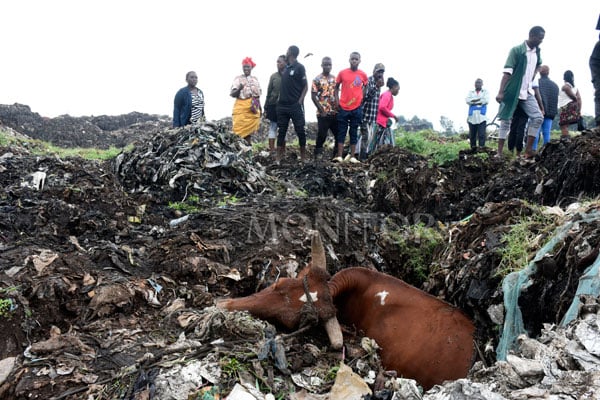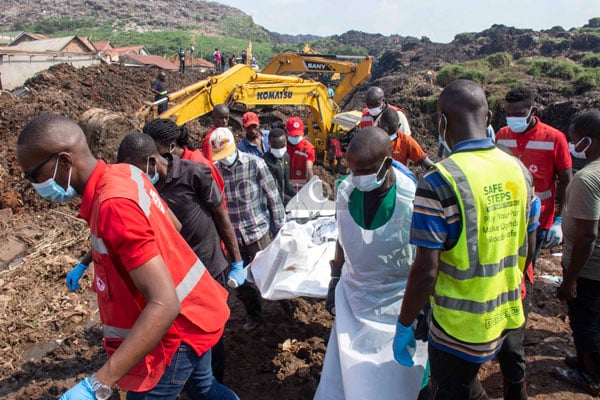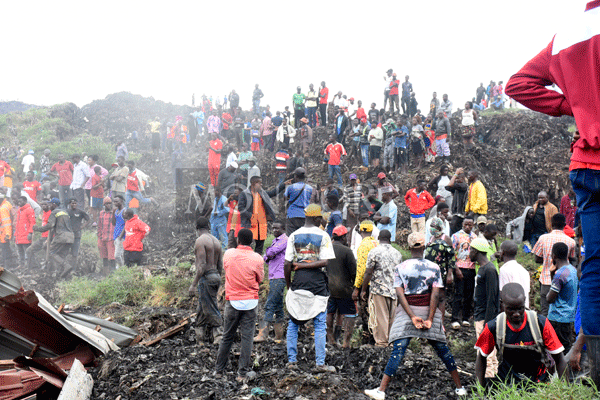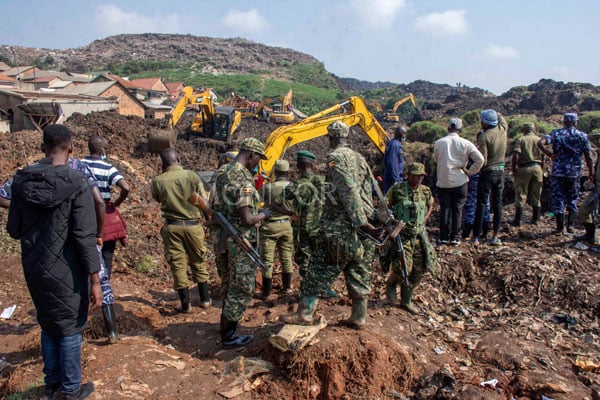
A carcass of a cow trapped in the garbage which collapsed on houses burying several people and livestock at Kiteezi Landfill on August 10, 2024. PHOTO/ISAAC KASAMANI
The police and the Inspectorate of Government yesterday said they are investigating whether there was negligence on the side of government workers.
As rescue teams search for more people who could be buried by the Kiteezi landfill which collapsed on Saturday, questions are being asked why the authorities ignored several red alerts.
Authorities last evening confirmed at least 23 bodies had been retrieved, more than 14 victims rescued, several livestock killed, and properties worth millions lost following the collapse of the Kiteezi landfill in Kasangati Town Council, Wakiso District.

Red cross officials carry a body of a woman who was retrieved from the garbage at Kiteezi landfill. The death toll is expected to rise as the search and rescue operation at the landfill where garbage fell on several house is ongoing. PHOTO/ ISAAC KASAMANI
Mr Nkunyingi Muwanda, the area Member of Parliament and a lawyer, said what happened at Kiteezi is criminal negligence on the part of Kampala Capital City Authority (KCCA) and government.
“A few months ago, I reached out to KCCA and the Minister of Kampala Metropolitan Affairs after the drainage of the landfill was blocked and water spread to people’s homes. [KCCA executive director] Ms [Dorothy] Kisaka and [State Minister for Kampala and Metropolitan Affairs] Kyofatogabye Kabuye visited and promised to solve the problem,” Mr Nkunyingi said yesterday.
Geotechnical engineers cite water as the main lubricant that leads to the collapse of landfills.
The police and the Inspectorate of Government yesterday said they are investigating whether there was negligence on the side of government workers that led to the death of 21 people in the landfill slide.
Mr Nkunyingi said during the visit by Ms Kisaka and Mr Kyofatongabye, the residents demanded that KCCA deploys standby engineers at the landfill to monitor the situation and compliance with the standards, which wasn’t done.
“That is negligence on the part of the KCCA and government. The outcries by the residents have been regular,” he said.
Only a few weeks ago, he said, some Chinese experts visited the landfill and installed pipes to test whether the gas in the waste was economically viable.
“The residents told me that as the Chinese were working, they heard a huge blast that raised dust that covered the area. We don’t know whether it was the gas that caused the blast and affected the stability of the landfill that it later gave way,” he said.
Numerous experts, government agencies and international organisations had indicated that Kiteezi landfill had lived beyond its design life and had become a time bomb.

Distressed residents of Kiteezi, Kawempe Division talk to journalists after their relatives were buried by a garbage heap at Kiteezi landfill on August 10, 2024. PHOTO/ ISAAC KASAMANI
Only last year, President Museveni issued an Executive Order Number 2 of 2023, with three directives, aimed at ensuring the authorities get rid of garbage with a deadline of one year.
“Within a year, every urban authority (city, municipality or town) must ensure there is a plan for recycling that waste so that the dumping sites do not become mountains of rubbish. The plastics should be recycled into new use forms (bags); the organic waste (peelings –ebihatiro) should be turned into manure; and wastepaper should be recycled into new uses of paper (toilet paper),” he directed.
The managers of the 32-acre Kiteezi landfill, which was established in 1996 as the only solid waste disposal place for the city, was also expected to comply with the President’s directive.
The directive wasn’t accompanied with more funding.
But the landfill had reached its capacity by 2008.
An impact assessment report on Kiteezi landfill by Kampala City Council (now Kampala Capital City Authority) in 2008, showed the city was disposing of 500 tonnes of garbage per day at Kiteezi.
By 2008, the landfill was full, prompting the city authorities to buy more six acres to give the landfill another two-year lifetime.
Kiteezi was to be closed in 2010, but it wasn’t since the city authorities hadn’t established an alternative landfill.

Residents gathered at Kiteezi landfill where a heap of garbage fell on houses and livestock on August 10, 2024. PHOTOS/ ISAAC KASAMANI
A 2013 study of slope stability and settlement characteristics of Mpererwe landfill by two Makerere University students, Mr Bernard Wasswa and Dickness Kakitahi, indicated that the slopes of the landfill were stable, but were of concern during the rainy season.
“Due to increasing waste volumes, the height of the landfill has increased giving rise to steep slopes. The stability of these slopes has become a major concern, especially during the rainy season on the Northern tipping front,” the study read in part.
The report showed there were external disturbances in the places where dumping hadn’t been done for more than two years.
Mr Samuel Jjuuko, a geotechnical engineer and former lecturer at Makerere University, who was among the supervisors of Mr Wasswa and Mr Kakitahi, said by the engineering standards, Kiteezi was a dumping site, an indication that it doesn’t tick all the boxes.
“We may call it [Kiteezi], a dumping site not landfill. A landfill is engineered starting with layers down. Leachates are established to collect toxic liquids for treatment before it is released,” Mr Jjjuuko said yesterday, adding that there are several other processes they implement to ensure there is no landslide.
Mr Jjuuko said several calculations must be done about the slopes, height, toxicity and compactness of the waste to ensure there are no risks to the communities and environment.
“Solid waste is disposed of in layers to control stability. Soil is used to cover each layer and we compact it before dumping more garbage. We also measure the slopes and the water pressure,” he said.
Mr Jjuuko said he participated in drawing proposals funded by the United Kingdom’s Department for International Development to close Kiteezi 10 years ago, but the final product wasn’t realised.
In March last year, Ms Kisaka acknowledged that Kiteezi had been filled and said they had acquired a landfill in Dundu, Mukono District.
“We acquired 135 acres of land in Dundu Mukono to set up a waste recycling plant and relieve the Kiteezi landfill. In collaboration with the Ministry of Health, a medical waste handling facility is being set up there, occupying five of the 135 acres. This facility is now at roofing stage,” she said.
Ms Kisaka said they were to build access roads and a treatment centre.

In January, KCCA Lord Mayor Erias Lukwago visited the Kiteezi landfill where he expressed fear of a health hazard due to unbearable stench in the area.
Mr Lukwago asked the government to close the landfill and get a new area to dump solid waste.
Some of the deceased
1. Ernest Nasser
2. Nuwary Kironde
3. Sam Kajubi
4. Meddy Mubiru
5. Shamon Muhammed
6. Halima Nakalume
7. Phiona Mulikedete
8. Three months old baby of Mukadete
9. James Kasule
10. Emmanuel Mukose
11. Grace daughter of Anne Maria
12. Brenda Kawuki
13. Sharon Housemaid of Brenda
14. Tiful Kikambi
15. Jesca Nantege
16. Esther Nalubega
17. Whitney Nabulya, three years old.
18. Kawesa
19. Ronald Lwere, 20 years old
20. Kiyemba
21. Wife of Kiyemba
